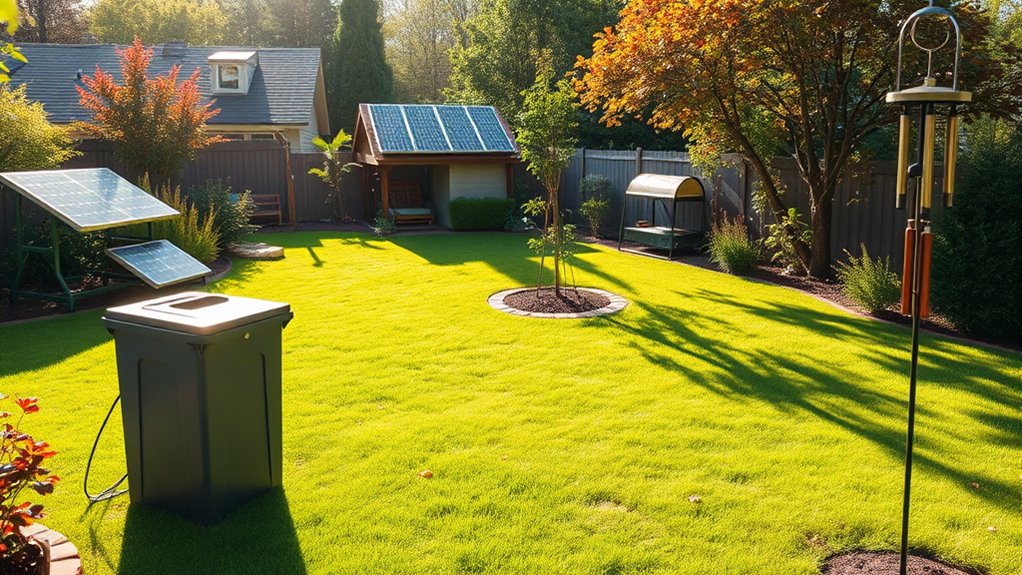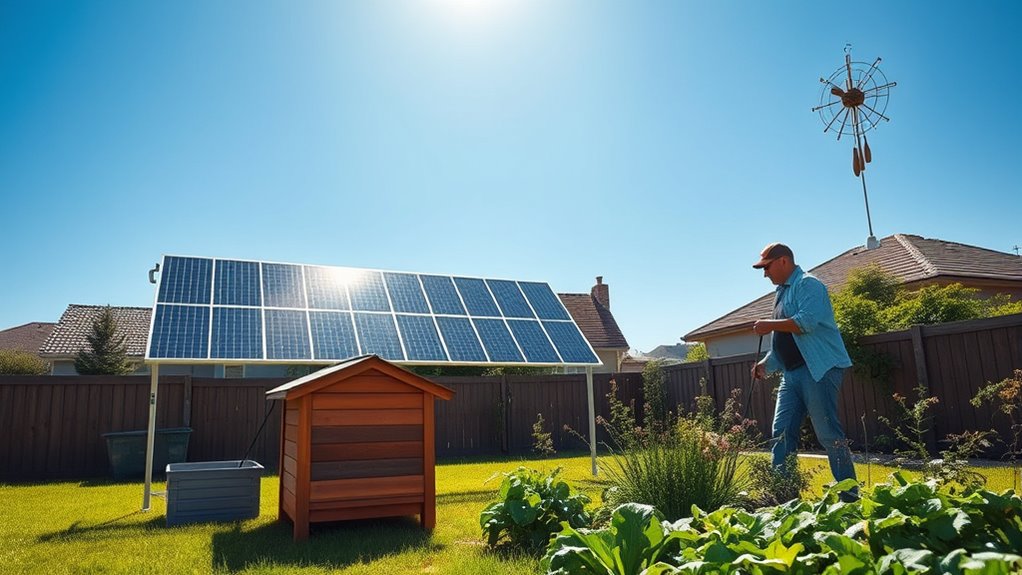Carbon offsets can be worthwhile for homeowners when used alongside efforts to boost energy efficiency and switch to renewable energy sources. They help neutralize any remaining emissions that are hard to eliminate, supporting projects like reforestation or clean energy initiatives. However, offsets are most effective when combined with tangible actions, not as a replacement. If you want to explore how to make your home more sustainable, keep exploring these options further.
Key Takeaways
- Carbon offsets can supplement reduction efforts but are less effective without prior energy efficiency and renewable energy upgrades.
- Using offsets alone may be wasteful if homeowners haven’t minimized their direct emissions first.
- Combining offsets with tangible actions like insulation and renewable energy maximizes overall carbon footprint reduction.
- Offsets support projects like reforestation and renewable energy, but should not replace concrete home upgrades.
- Prioritizing tangible reductions ensures offsets are meaningful and not just an unnecessary expense.

Are you wondering how you can reduce your home’s carbon footprint effectively? One way to do this is by exploring the benefits of renewable energy and improving your home’s energy efficiency. Implementing renewable energy sources like solar panels or small wind turbines can substantially cut down your reliance on fossil fuels. Not only do these options generate clean power, but they also help you save money over time through lower energy bills. By investing in renewable energy, you’re taking a proactive step toward reducing your carbon emissions and making your home more sustainable.
Reducing your home’s carbon footprint with renewable energy and energy efficiency is both smart and sustainable.
However, before diving into renewable energy installations, it’s important to assess your home’s energy efficiency. Upgrading insulation, sealing leaks, and replacing old appliances with energy-efficient models can drastically reduce the amount of energy your house consumes. These improvements make your home less dependent on external energy sources, which means fewer emissions associated with power generation. The more energy-efficient your house becomes, the less you need to offset through other means. This approach guarantees that your efforts to lower your carbon footprint are both effective and economical.
While renewable energy and energy efficiency measures are powerful strategies, some homeowners turn to carbon offsets to balance out unavoidable emissions. Carbon offsets involve purchasing credits that fund projects like reforestation, renewable energy development, or methane capture. These projects absorb or prevent the release of greenhouse gases, effectively neutralizing your remaining emissions. But it’s vital to understand that offsets shouldn’t replace direct action. If you focus solely on offsets without making tangible changes—like switching to renewable energy or upgrading your home’s efficiency—you might be wasting your money. Offsets work best when they complement concrete steps rather than serve as a license to do nothing.
When considering whether carbon offsets are worth it, think about the bigger picture. Are you making your home as energy-efficient as possible? Are you investing in renewable energy sources? If the answer is yes, offsets can be a useful way to achieve neutrality, especially for emissions that are difficult to eliminate entirely. But if you haven’t taken those initial steps, offsets might be a waste of resources. They shouldn’t be your primary strategy; instead, focus on reducing your energy consumption and switching to renewable energy options first. Once you’ve maximized those efforts, offsets become a practical way to offset the last remnants of your carbon footprint.
In the end, the most effective approach combines making your home more energy-efficient, adopting renewable energy, and thoughtfully using offsets where necessary. This integrated strategy ensures you’re genuinely reducing your impact rather than just paying for it to be offset. Additionally, embracing emerging technologies like smart home systems can further optimize energy use and maximize efficiencies.
Frequently Asked Questions
How Do I Verify the Credibility of a Carbon Offset Provider?
When verifying a carbon offset provider, start with a credibility check by researching their certifications and reviews. Look into their provider reputation by checking independent third-party organizations like Verra or Gold Standard. Confirm their projects are transparent, measurable, and verifiable. Ask for detailed documentation and avoid providers that lack clear information. Doing this helps you confidently choose a trustworthy provider, making your investment in offsets genuinely impactful.
Are There Tax Incentives for Purchasing Carbon Offsets?
Imagine you buy a carbon offset that funds renewable energy projects through carbon trading. In some regions, like California, you might qualify for tax incentives that reduce your overall tax bill. These incentives encourage investments in cleaner energy and help offset your carbon footprint. While not universal, researching local policies can reveal if purchasing offsets offers tax benefits, making your eco-friendly choices even more rewarding.
Can Carbon Offsets Fully Negate My Homeowner’S Carbon Footprint?
You can’t fully negate your homeowner’s carbon footprint with offsets. While renewable energy projects and land conservation efforts help reduce emissions, offsets are only part of the solution. They compensate for some emissions but don’t eliminate all your impact. To truly lower your carbon footprint, prioritize renewable energy systems at home and support land conservation initiatives, ensuring your efforts contribute to meaningful climate change mitigation.
How Much Do Carbon Offsets Typically Cost for Homeowners?
Imagine buying a tiny island of clean air for your home—carbon offsets can cost anywhere from $5 to $50 per ton. You’ll find pricing transparency varies, so watch out for hidden fees. Project types range from reforestation to renewable energy. For homeowners, small offsets might be affordable, but if you want significant impact, be prepared for higher costs. Always compare options to make the most of your investment.
What Are the Environmental Impacts of Carbon Offset Projects?
You might wonder about the environmental impacts of carbon offset projects. These initiatives help fight climate change by supporting renewable energy sources, like wind or solar, reducing greenhouse gases. Positive effects include improved air quality and preserved ecosystems. However, some projects can cause habitat disruption or be less effective if not properly managed. Overall, well-designed offsets contribute positively to environmental health and the global effort to combat climate change.
Conclusion
Ultimately, deciding if carbon offsets are worth it is like planting a seed—you might not see immediate results, but with patience and commitment, they can grow into meaningful change. While offsets alone won’t solve climate issues, they’re a crucial part of your environmental toolkit. Think of them as stepping stones across a rushing river—small, but necessary to reach the other side. Your choices today shape a cleaner, greener tomorrow.









